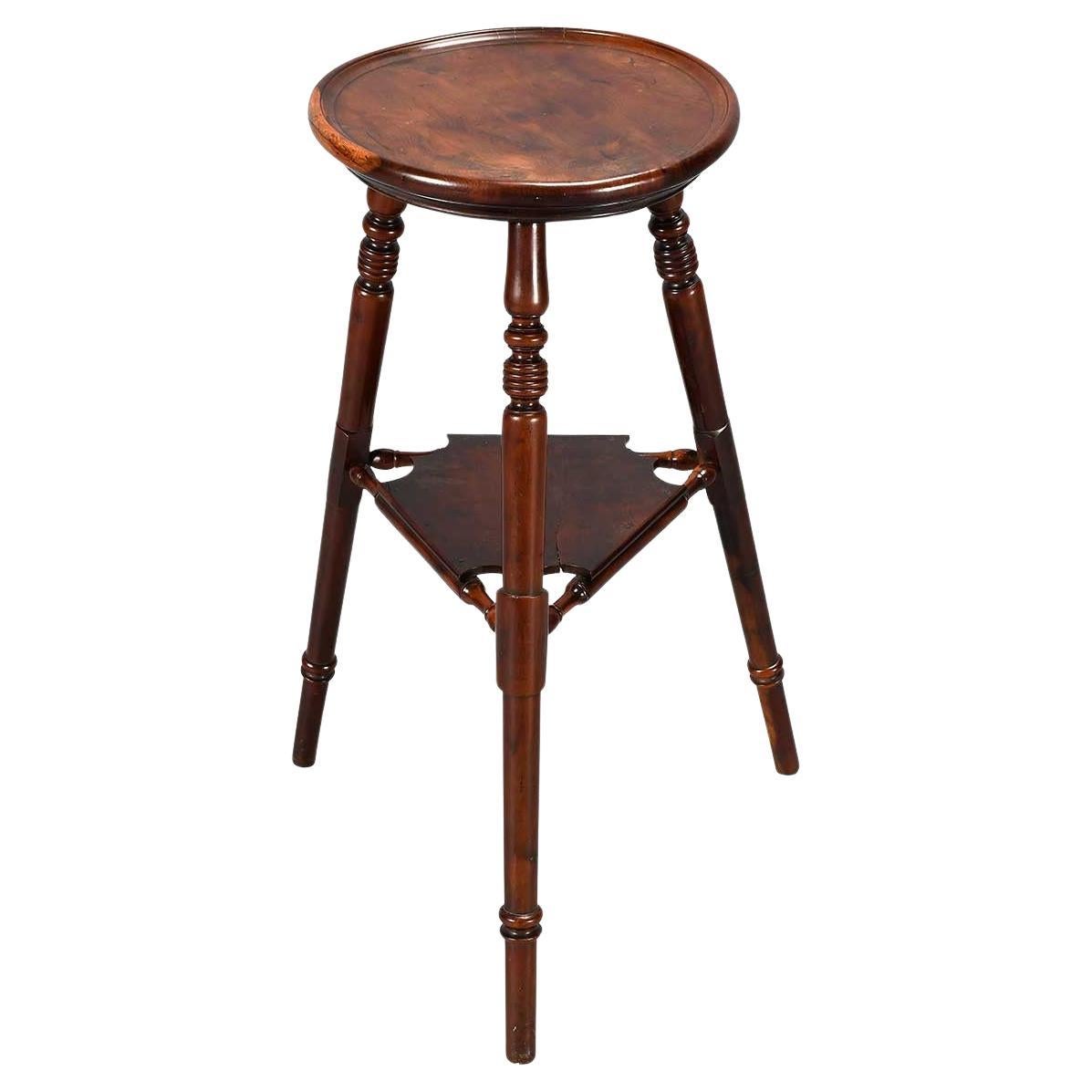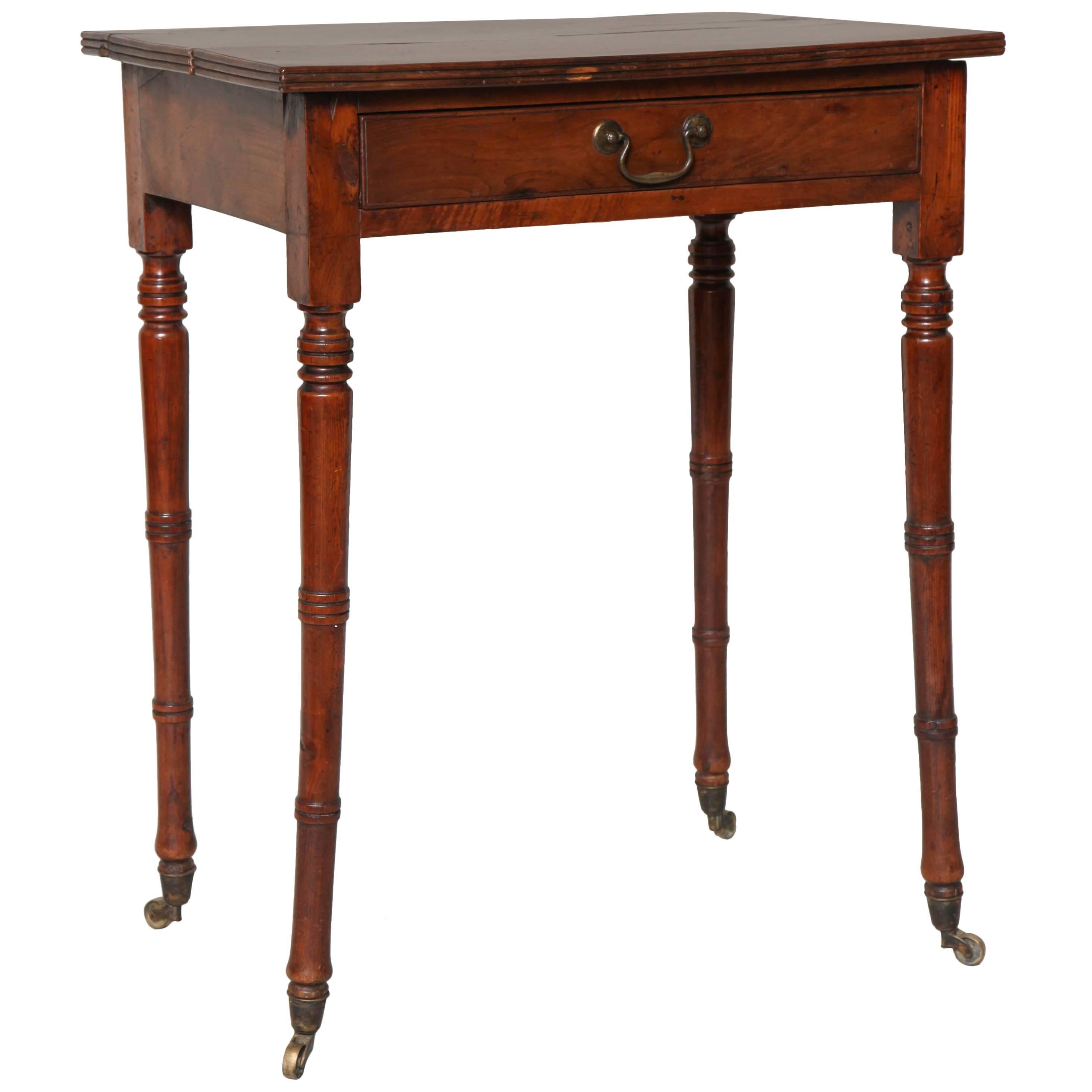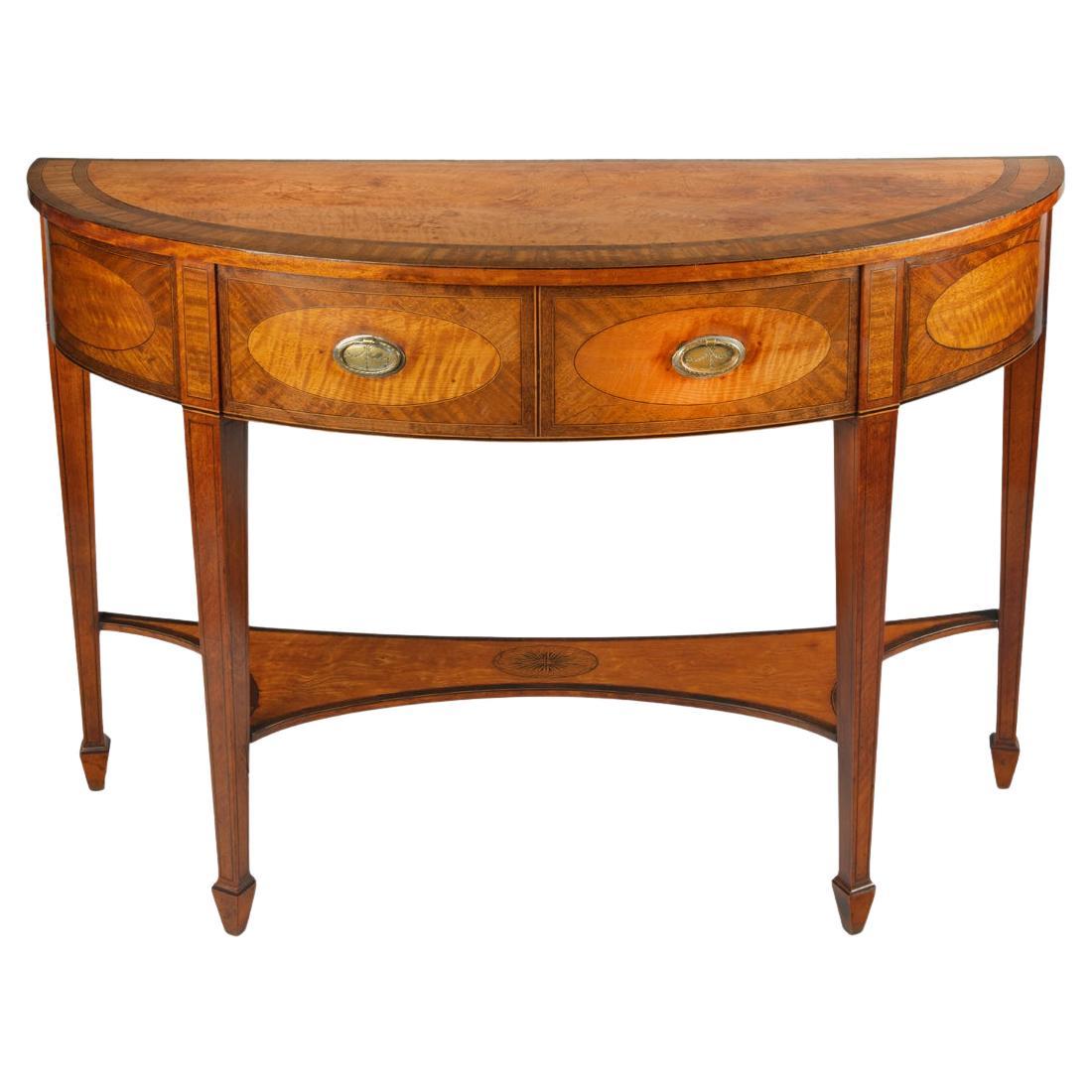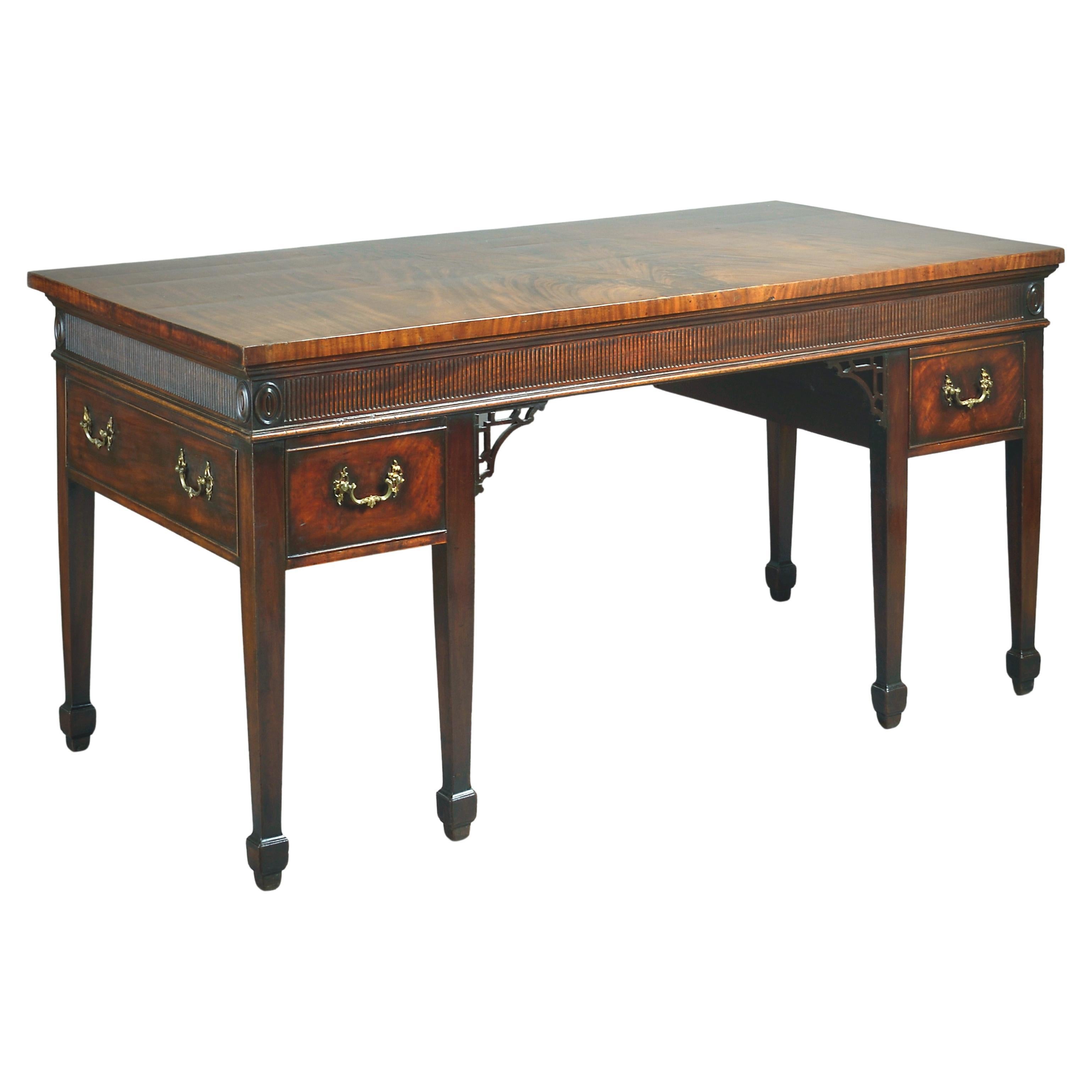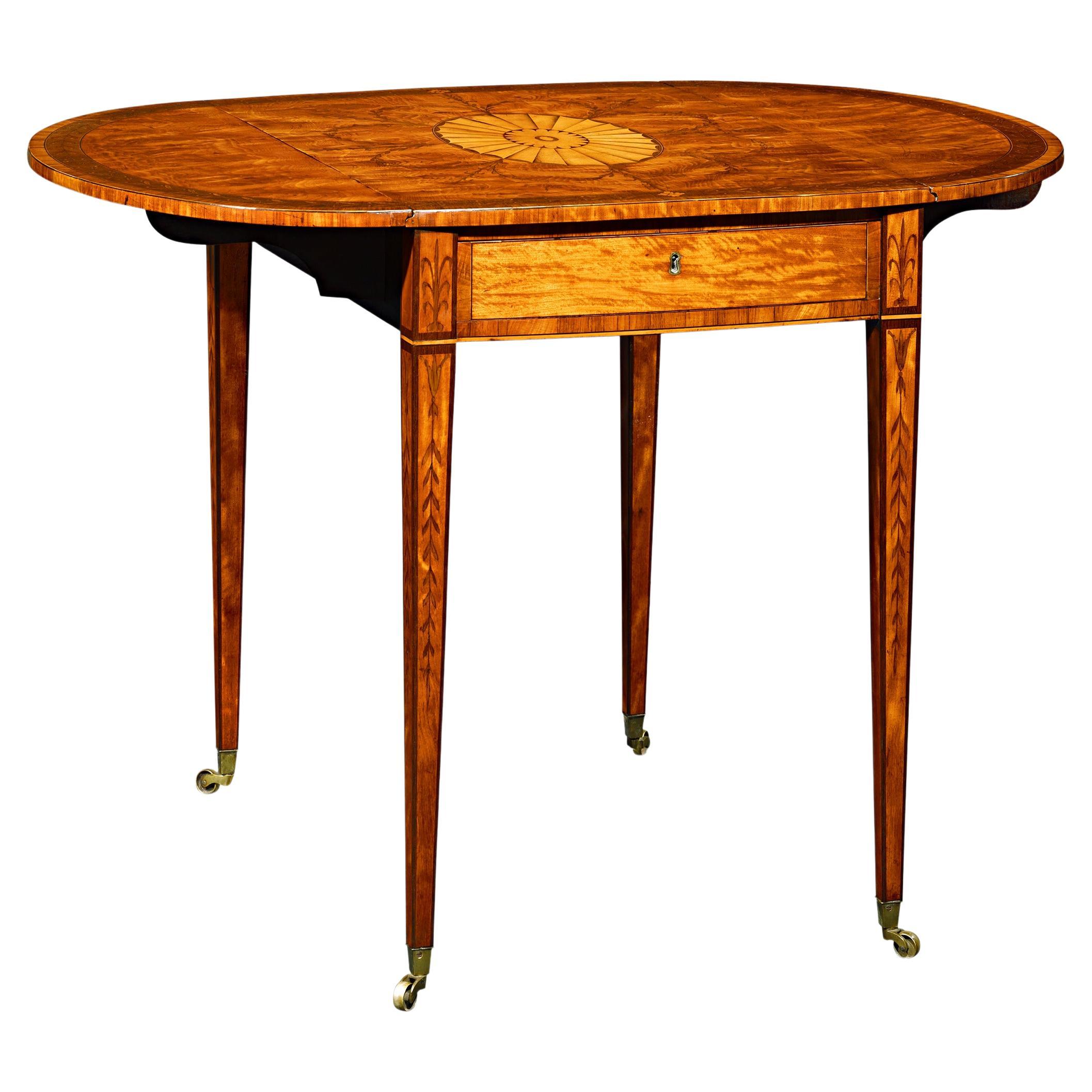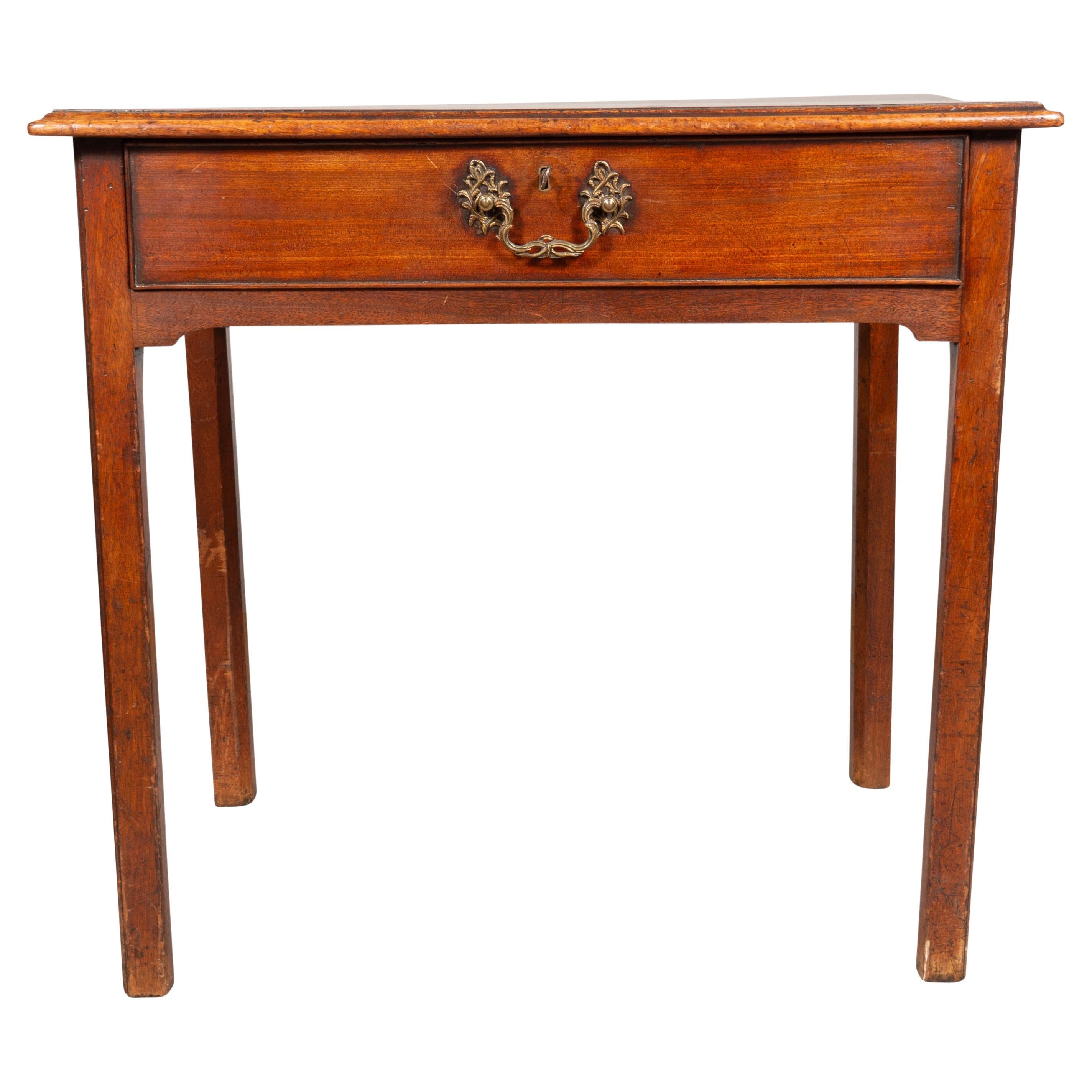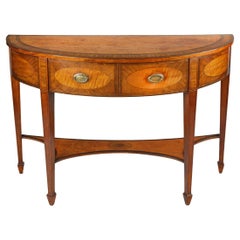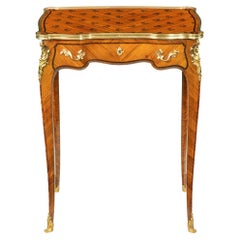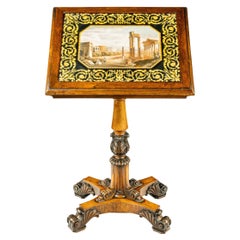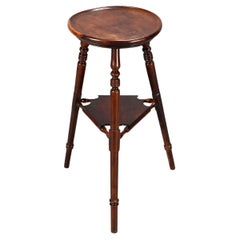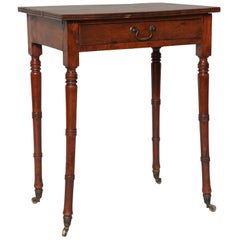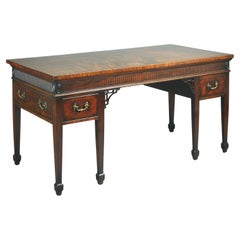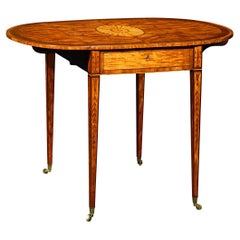Items Similar to An interesting George III yew wood marquetry side table, firmly attributed to In
Want more images or videos?
Request additional images or videos from the seller
1 of 12
An interesting George III yew wood marquetry side table, firmly attributed to In
About the Item
An interesting George III yew wood marquetry side table, firmly attributed to Ince and Mayhew, the demilune top veneered principally in burr yew wood inlaid with a fan of satinwood and radiating harewood, separated by holly stringing, the frieze cross banded in harewood with each panel containing a design featuring feathered boss-type paterae and swags of drapery, with penwork detailing, raised on four tapering square section legs with collared toes. English, circa 1780.
Provenance: A distinguished European private collection.
Footnote: The feathered bosses are a particular feature of the inlay work of the Ince and Mayhew partnership, one of the most prominent firms operating in London in the late 18th century. In their book ‘Industry and Ingenuity – The Partnership of William Ince and John Mayhew’ Sir Hugh Roberts and Charles Cator identify the source for these feathered bosses as Robert Wood’s 1753 publication ‘The Ruins of Palmyra’. This book is credited by many with establishing the craze for neoclassicism in Europe and the relevant plate, depicting all manner of feathered boss designs from a ceiling in Palmyra, is illustrated below. The blocks on the frieze of our table are inlaid with large scale and stylised harebells and the legs also incorporate the feathered boss motifs and tapering feathered panels.
Further indications of a likely Ince and Mayhew authorship for the present piece are provided by the extensive use of burr yew, a trademark of the firm’s production and the engraved detailing applied to the inlay to give it additional depth and character.
A side or serving table of similar character but with different sources of inlay is in Kingston Lacy in Dorset, having been supplied by Ince and Mayhew to the Bankes family there in 1786.
- Attributed to:Ince & Mayhew (Maker)
- Dimensions:Height: 34 in (86.36 cm)Width: 60 in (152.4 cm)Depth: 23.75 in (60.33 cm)
- Style:George III (In the Style Of)
- Materials and Techniques:
- Place of Origin:
- Period:
- Date of Manufacture:Circa 1780
- Condition:Wear consistent with age and use.
- Seller Location:Lymington, GB
- Reference Number:1stDibs: LU973041142912
About the Seller
5.0
Recognized Seller
These prestigious sellers are industry leaders and represent the highest echelon for item quality and design.
Established in 1982
1stDibs seller since 2013
128 sales on 1stDibs
Typical response time: 6 hours
Associations
LAPADA - The Association of Arts & Antiques Dealers
- ShippingRetrieving quote...Shipping from: Lymington, United Kingdom
- Return Policy
Authenticity Guarantee
In the unlikely event there’s an issue with an item’s authenticity, contact us within 1 year for a full refund. DetailsMoney-Back Guarantee
If your item is not as described, is damaged in transit, or does not arrive, contact us within 7 days for a full refund. Details24-Hour Cancellation
You have a 24-hour grace period in which to reconsider your purchase, with no questions asked.Vetted Professional Sellers
Our world-class sellers must adhere to strict standards for service and quality, maintaining the integrity of our listings.Price-Match Guarantee
If you find that a seller listed the same item for a lower price elsewhere, we’ll match it.Trusted Global Delivery
Our best-in-class carrier network provides specialized shipping options worldwide, including custom delivery.More From This Seller
View AllAn unusual George III satinwood side table
Located in Lymington, Hampshire
An unusual George III satinwood side table, the demi lune top crossbanded with mahogany, the frieze inlaid with satinwood ovals, two with the original silvered brass handles and conc...
Category
Antique 18th Century English George III Side Tables
Materials
Satinwood
Delicate Napoleon III Kingwood Parquetry Side Table Attributed to Sormani
By Paul Sormani
Located in Lymington, Hampshire
A delicate Napoleon III kingwood parquetry side table attributed to Sormani, the shaped serpentine top with a single frieze drawer above tapering cabriole legs, decorated with inlaid...
Category
Antique 1860s European Napoleon III Side Tables
Materials
Kingwood
A George IV rosewood and scagliola occasional table attributed to Gillows c.1825
By Gillows of Lancaster & London
Located in Lymington, Hampshire
The rectangular top of this table tilts up to display a scagliola landscape scene showing the ruins of the Roman Forum, the Temples of Vespasian and Saturn, the Column of Phocas and ...
Category
Antique 1820s English William IV Side Tables
Materials
Scagliola, Rosewood
Fine Pair of George III Mahogany Wine Cisterns Attributed to Gillows
By Gillows of Lancaster & London
Located in Lymington, Hampshire
Each cistern is in the form of a fluted vase on a rectangular pedestal. The lead-lined vases have brass handles, removable lids with pineapple finials and taps. The crossbanded pedestals have cupboard doors enclosing slatted shelves for warming plates in one and a lead-lined slops drawers, a tambour fronted shelf and a cellaret in the other.
Susan Stuart, 'Gillow of Lancaster and London', 2008 vol 1 p308-315 illustrates many pedestal urns including the drawings for Workington Hall, Cumbria, dated 1788. PLates 342 and 343 show pedestals with a similar arrangement of shelves and drawers. Thomas Sheraton explained the functions of dining room pedestals in his 'Drawing Book' of 1793: 'IN spacious dining rooms the sideboards are often made without drawers of any sort, having simply a rail, a little ornament...
Category
Antique 19th Century English George III Obelisks
Materials
Mahogany
Octagonal Indigenous Specimen Wood Marquetry Table
Located in Lymington, Hampshire
An octagonal indigenous specimen wood marquetry table, the tilt top inlaid on both sides with triangles and diamonds in an overall star design, the woods include yew, oak and elm, on...
Category
Antique 1860s British Side Tables
Materials
Wood
An unusual George IV specimen marble backgammon table attributed to Gillows
By Gillows of Lancaster & London
Located in Lymington, Hampshire
An unusual George IV specimen marble backgammon table attributed to Gillows. This rectangular table is strongly attributed to Gillows. It has a rectangular top inlaid with a central chess board flanked by two backgammon fields, all inlaid with a multitude of specimen marbles. One edge carved and gilded with the Latin motto ‘Turpe est in patria vivere et patriam ignorare’. The oak base has a drawer for cards and playing pieces, all raised on a square section support with four splayed legs and the original brass castors. English, circa 1830.
Provenance: Geoffrey Bennison Ltd, London, November 1983
The Mermaid House Collection, St. John’s Wood, London
Property of a gentleman
Private American collection
The form of the base of this table is related to several known Gillows commissions from the late Regency period and the quality of the cabinet work also suggests that firm attribution to the firm. Backgammon tables, rather than more general games tables, are unusual at this date and the use of inlaid specimen marbles in the top suggests a client of wealth. Additionally, the Latin text on the edge of the table provides further clues. The text, Turpe est in patria vivere et patriam ignorare, translates as “it is shameful to live in your homeland and not know it”. This phrase dates back to antiquity but rose to prominence once again in the mid-18th century when used by the botanist and key Enlightenment figure Carl Linnaeus in his work on the native flora of Sweden. The combination of this phrase and the use of native English timbers and marbles is promoting English raw materials and craftsmanship at a time when the noble and the wealthy were focussed on European pietra dura tables.
Mermaid House in St John’s Wood was re-designed by Chester Jones...
Category
Antique 1830s English George IV Game Tables
Materials
Marble
You May Also Like
George III Period Yew Wood Cricket Table
Located in Harrodsburg, KY
A fine and unusual cricket table in solid yew wood. The circular top has a dished edge. The legs are skillfully turned and joined by similarly turned stretchers which are surmounted ...
Category
Antique Early 19th Century English George III Side Tables
Materials
Yew
Yew Wood Side Table
Located in Greenwich, CT
Fine George III yew wood side table, the two plank top with ribbed edge, the single drawer with original swan neck pulls, standing on ring turned tapered legs ending in original bras...
Category
Antique Early 19th Century English George III Side Tables
Materials
Yew
$5,900
George III Mahogany Side Table Attributed to Mayhew & Ince
Located in London, GB
A FINE GEORGE III MAHOGANY SIDE TABLE ATTRIBUTED TO MAYHEW & INCE, CIRCA 1770.
With finely figured book-matched top above a fluted frieze applied with oval medallions and a drawer a...
Category
Antique 18th Century Side Tables
Materials
Mahogany
George III Pembroke Table attributed to Ince & Mayhew
By Ince & Mayhew
Located in New Orleans, LA
This extraordinary George III-period Pembroke table by London cabinetmakers Ince & Mayhew displays the understated sophistication of the late Georgian era. The surface of the table — including both the central panel and the signature Pembroke hinged flaps — is beautifully detailed with satinwood marquetry, inlaid with a fan medallion and foliate motifs executed with the greatest precision and craftsmanship. The table is set upon slender, tapering legs. The design is indicative of the rising influence of and interest in Neoclassical patterns, favoring motifs from nature or Classical antiquity over the extravagance of the Rococo style.
William Ince and John Mayhew joined their skills as furniture designers and cabinetmakers, opening a firm together on Broad Street in 1759. Over the next forty years, the duo would execute many commissions, and develop a volume of engraved designs entitled The Universal System...
Category
Antique 18th Century English Georgian Drop-leaf and Pembroke Tables
Materials
Satinwood
George III Mahogany Side Table
Located in Essex, MA
With a molded rectangular top over a single drawer with brass bail handle raised on square section legs.
Category
Antique Late 18th Century English George III Side Tables
Materials
Brass
An Unusual Marquetry Top Table Attributed to Jackson & Graham
By Jackson & Graham
Located in London, GB
An Unusual Marquetry Top Table
Attributed to Jackson & Graham
Likely Designed by Bruce James Talbert (1838-1881)
The circular top inlaid with a p...
Category
Antique 19th Century English Side Tables
Materials
Wood, Mahogany, Amboyna
